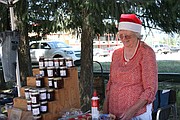Libby and Troy: A tale of two farmers markets
Farmers markets in Troy and Libby contribute economically to Lincoln County and help to build a healthy social community. But as they grow, and as more people become involved as vendors or customers, what the markets are and who they serve becomes more important — and more controversial.
The economic impact of a farmers market is significant. Troy’s figures, taken from data gathered each week from each vendor by market coordinator Shawna Kelsey, show $20,500 circulated through the 11-14 vendors participating in the market for the 2016 season (June-September). Libby’s market master, Juanita Schikora, said although no official records are kept, she would estimate an average of $100 in earnings per vendor with 10-14 vendors per week, making a seasonal (May-September) total of between $4,000 and $6,000.
Success can be measured in more ways than dollars, however, and it’s the social aspects of farmers markets that are often the most celebrated.
Helen Tarbert, assistant at the Libby market, said she likes the social outlet of being part of the market.
“I enjoy people,” she said. “I meet a lot of tourists and I like talking with the other vendors. We’ll ask each other ‘lookers or buyers?’”
A recent Facebook discussion on the Libby/Troy Area News and Opinion page provided plenty of feedback about various aspects of the markets. The feedback debated about the best day and time to hold a farmers market and a desire for a visible and pleasant location, but most comments were about food — many people want more food at their farmers markets.
Donna Watson wrote she would like to see more vegetables and fewer crafts — “(we) need food vendors to keep people there” — while Dorothy Smith wrote she would like to see more locally sourced and seasonal fresh produce.
Tarbert said she bought green onions and lettuce to the market earlier this spring, but couldn’t sell them.
“It’s such a short growing season in Libby,” Schikora said. “I think we get about 45 days and it’s 90 days in Troy.”
Kelsey said although she aims to keep a balance of handmade items and food items, she and the market board want to keep the balance strongly in favor of local produce and handmade food products.
Food items available to eat while shopping at markets were also mentioned often in the Facebook comments.
“More fresh produce would be nice,” wrote Deena Farris-Jellesed. “Maybe some actual food items, like chicken on a stick, asparagus skewers, beverages. I miss when kettle corn was there.”
Beckie Guerra suggested in a post that “the lady who makes cotton candy and caramel apples would be an awesome addition,” as would food trucks.
The Libby market is held Thursdays from noon until 6 p.m. aside the Libby Area Chamber of Commerce, while the Troy market is held 3 p.m. 6:30 p.m. Fridays next to the Troy Museum.
Libby’s market is run by volunteers, and although it uses the chamber grounds it is not associated with the organization. Schikora said she has been market master for 11 years, and Tarbert her assistant for that time.
In contrast, Troy’s market is in its fifth season and is run by Kelsey, who is paid by nonprofit The Yaak Valley Forest Council in her role as community development coordinator, and has access the Forest Council’s grant writer to apply for funding to support the market’s growth.
A registered nonprofit itself, the Troy market funnels any profits back into the market, this year focusing on “the introduction of SNAP processing, building even more community access to fresh food,” Kelsey said.
Schikora said any profits from vendor fees she gives back to the community. “If I see someone from the fire department or the pregnancy care center, I just give them the cash,” Schikora said. “I try to rotate through all the charities in town.”
Libby’s location on the chamber grounds was debated on the Facebook feed. Comments noted the lack of shade, lack of visibility of the market from the road and the way booths are spread out and fragmented.
“I believe it doesn’t matter what day of the week it is held it needs better advertising and a better location you can’t even see the vendors very well as you drive-by,” wrote Richelle Torgerson Vinion. “In Troy you can see that there is activity going on because of the location it’s not because of the day that they are holding it on.”
While Diane Higdem had a positive attitude towards the market in general, she wrote “the market location did not inspire me to enter its grounds.” She also lamented “the absence of people.”
Several people commented that a better location for the Libby market might be the pavilion near the Kootenai River.



